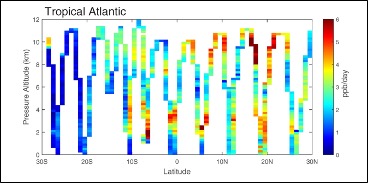The ORNL DAAC recently released the following Atmospheric Tomography Mission (ATom) dataset by Guo, H., et al. (2022):
ATom: Data Stream for Modeling the Reactivity of ATom Air Parcels, 2016-2018
This dataset provides Modeling Data Stream (MDS) and Reactivity Data Stream (RDS) products for each of the four ATom campaigns conducted from 2016 to 2018. MDS files contain the atmospheric constituents needed to model the RDS of the air parcels along ATom flight paths. The MDS is a continuous data stream (every 10 seconds) of the atmospheric content of these key chemical species derived from the in-situ measurements collected along ATom flight paths (as reported in the comprehensive related dataset ATom: Merged Atmospheric Chemistry, Trace Gases, and Aerosols). Values for chemical species measured by multiple instruments were selected from the instrument with better coverage and/or greater precision. Missing values were filled using interpolation for short gaps. For long gaps owing to instrument failure, values were estimated using multiple linear regressions from comparable parallel flights from other ATom campaigns. All species were flagged for instrument source and values were flagged for gap-filling status. In combination, MDS and RDS provide, in essence, a photochemical climatology for each air parcel along ATom flight paths containing the reactive species that control the loss of methane and the production and loss of ozone.
The Atmospheric Tomography Mission (ATom) is a NASA Earth Venture Suborbital-2 mission to study the impact of human-produced air pollution on greenhouse gases and on chemically reactive gases in the atmosphere. ATom deployed an extensive gas and aerosol payload on the NASA DC-8 aircraft for systematic, global-scale sampling of the atmosphere, profiling continuously from 0.2 to 12 km altitude. Around-the-world flights were conducted in each of four seasons between 2016 and 2018.
Additional data from ATom and other relevant links can be found on the ORNL DAAC's ATom Project Page.
Citation: Guo, H., C.M. Flynn, M.J. Prather, S.A. Strode, S.D. Steenrod, L. Emmons, F. Lacey, J.-F. Lamarque, A.M. Fiore, G. Correa, L.T. Murray, G.M. Wolfe, J.M. St.Clair, M.J. Kim, J.D. Crounse, G.S. Diskin, J.P. DiGangi, B.C. Daube, R. Commane, K. McKain, J. Peischl, T.B. Ryerson, C.R. Thompson, T.F. Hanisco, D.R. Blake, N. Blake, E.C. Apel, R.S. Hornbrook, J.W. Elkins, E.J. Hintsa, F.L. Moore, and S.C. Wofsy. 2022. ATom: Data Stream for Modeling the Reactivity of ATom Air Parcels, 2016-2018. ORNL DAAC, Oak Ridge, Tennessee, USA. https://doi.org/10.3334/ORNLDAAC/1877

